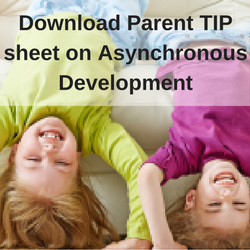NAGC works to support those who enhance the growth and development of gifted and talented children through education, advocacy, community building, and research
Asynchrony is the term used to describe the mismatch between cognitive, emotional, and physical development of gifted individuals. 1 Gifted children often have significant variations within themselves and develop unevenly  across skill levels. For example, a gifted child may be excellent in math, but poor in reading--or vice versa. Often, intellectual skills are quite advanced, but fine motor or social skills are lagging. Experts do not completely agree, but because asynchrony is so prominent in gifted children, some professionals believe asynchronous development rather than potential or ability, is the defining characteristic of giftedness. 2
across skill levels. For example, a gifted child may be excellent in math, but poor in reading--or vice versa. Often, intellectual skills are quite advanced, but fine motor or social skills are lagging. Experts do not completely agree, but because asynchrony is so prominent in gifted children, some professionals believe asynchronous development rather than potential or ability, is the defining characteristic of giftedness. 2
A definition of giftedness that captures the essence of this uneven development was developed by the Columbus Group in 1991:
Giftedness is asynchronous development in which advanced cognitive abilities and heightened intensity combine to create inner experiences and awareness that are qualitatively different from the norm. This asynchrony increases with higher intellectual capacity. The uniqueness of the gifted renders them particularly vulnerable and requires modifications in parenting, teaching, and counseling in order for them to develop optimally.
It is important for parents, teachers, and caregivers to realize that "one size does not fit all" for gifted children--and even those with similar IQ scores may not have similar skills, personalities, rates of development, abilities, or interests. The individual traits of one gifted child may be extremely different from another. And, the more highly gifted the gifted child, the more asynchronous she may be. For example, it is not unusual for a 7-year-old highly gifted child to be reading at a 6th grade level, performing math tasks at a 4th grade level, and have fine motor skills at a 2nd grade level. At times, the child may appear to be functioning socially at a level far below her age mates.
1 Morelock, 1992.
2 Webb et al, 2007; The Columbus Group, 1991.